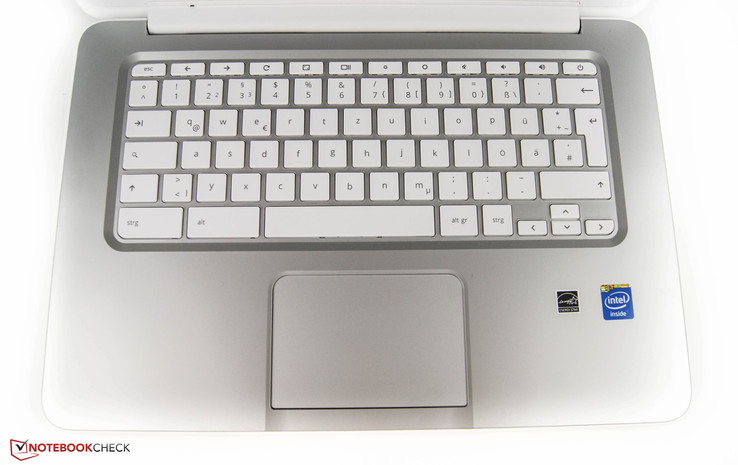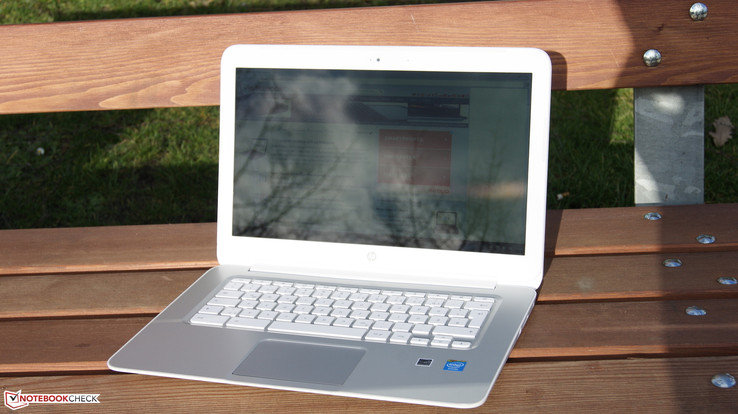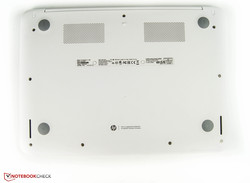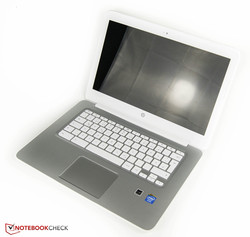HP Chromebook 14 G1 Notebook Review
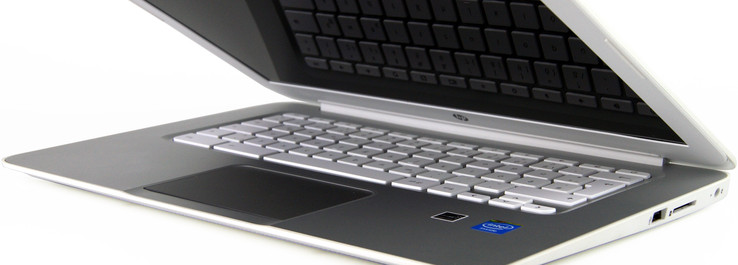
For the original German review, see here.
How much laptop do we really actually need? Rather than a full-scale Windows operating system, Google's Chrome OS based on GNU/Linux runs on Chromebooks. Last year the 11-inch version of HP's Chromebook lineup was on our test bench. Now we will take an in-depth look at the new 14-inch version. The browser-based operating system allegedly has enough power owing to an Intel Celeron 2955U and 4 GB of working memory. Furthermore, a 32 GB SSD with a Trusted Platform Module (TPM) is also available. The total package has a price tag of 350 Euros (~$379) and is again alone in the 14-inch category. We have tested 13.3-inch devices from Toshiba and Acer, which will be used for comparisons in the course of the tests. Toshiba's Chromebook CB30 features a slightly smaller configuration than our review sample with an Intel Celeron 2955U, 2 GB of working memory, and a 16 GB flash memory. Consequently, it is available for 300 Euros (~$325). Acer relies on Nvidia elements instead of Intel components. Acer's Chromebook 13 is also an interesting rival for a price of approximately 300 Euros (~$325).
Case & Connectivity
HP exclusively uses plastic parts. Apart from the area around the keyboard, the Chromebook is white. Both design and feel make a satisfactory impression and do not suggest the low price. Even a closer look at the build did not reveal any bigger flaws. The large hinge gives the display the needed stability, which was also consistent throughout our tests. The weight of 1836 grams allows carrying HP's Chromebook 14 even over longer distances without problems. A glance at the interfaces shows only the standard repertoire in terms of diversity. At least, the room has been used quite cleverly. Both high-speed USB 3.0 ports are on the left just like the other interfaces with permanently connected peripherals in mind. We only find one USB 2.0 port and the SD-card slot on the right. Consequently, cables of connected devices will not interfere in the work area. Only the power supply will have to be routed behind the laptop on this side.
A Wi-Fi module is installed for wireless communication. It is to achieve a downstream speed of up to 300 Mbps. The transfer rates are ascertained in a real-life situation in a personal test by the author. The Wi-Fi signal had to overcome two walls and a straight distance of 5 meters to the router. Both the review sample and a Surface Pro 3 managed a speed of 0.5 Mbps after several test downloads. The downstream speed increased to 0.55 Mbps when in the same room as the router.
Input Devices
Keyboard
The review sample's white keyboard conveniently features a roughened surface. It thus has enough grip for more energetic typing. All keys have a good and firm build, and they barely yield at the corners. The soft and short drop is pleasing and allows fast inputting. Even the noise development while typing is agreeably subdued. Only the space bar is somewhat louder and also has an even softer drop. The keyboard's upper row is comprised of command keys rather than FN and F keys. In summary, the keyboard can be called a decent input device for this price range. This keyboard will even satisfy prolific writers.
Touchpad
A 10 x 6.9 cm touchpad is available for finger inputs. Inputting was always smooth and even multi-touch gestures were recognized without difficulties. However, inputs made in the corners and edges were a problem. For example, the last 5 - 7 mm at the edges responded sporadically. Another quality drawback was noticed at the touchpad's lower edge. It juts out slightly from the rest of the keyboard. The pressure sensitivity of the incorporated keys changes from firm to smooth the more we move away from the center. However, the mouse replacement is overall useful.
Display
HP opted for a TN screen with a resolution of 1366x768 pixels. Instead of a glare-free screen, HP beefs up the image reproduction with a glossy surface. Acer's Chromebook 13, for example, provides a matte view. The review sample's average brightness of 227 cd/m² lags behind its rivals, which are slightly brighter with 240 cd/m². Fortunately, it does not dim in battery mode. Although the contrast of 565:1 and the resulting black level of 0.4 cd/m² do not provide a pitch black, it is better than the results of the contenders.
| |||||||||||||||||||||||||
Brightness Distribution: 86 %
Center on Battery: 226 cd/m²
Contrast: 565:1 (Black: 0.4 cd/m²)
Unfortunately, we could not perform an analysis and assessment of either the color-space coverage or color reproduction. Seen purely subjectively, the displayed image exhibits an evident bluish cast.
Not only the low brightness, but also the reflective design largely thwarts outdoor use. Use under cloudy conditions or in the shade is also mostly only possible for a short while.
Performance
As seen based on Acer's Chromebook 13 CB5, using a Chrome OS operating system does not exclusively require an x86 or x64 architecture. Nevertheless, HP opts for a 64-bit capable Intel Core 2995U processor. Furthermore, an integrated Intel HD Graphics (Haswell) and 4 GB of working memory are installed. This configuration predestines our review sample for office and Internet routines.
Intel's Core 2995U has two cores and a base clock of 1.4 GHz. Opposed to Intel's i-lineup, features like Turbo mode, AES, AVX and Hyper-Threading are disabled. The data sheet specifies a TDP of 15 watts. In contrast to Acer's Chromebook 13, the x64 instruction set is supported.
System Performance
The work speed in the browser-based operating system was always ideal. Scrolling through loaded pages, switching among multiple tabs or rendering YouTube videos were possible without much delay. That, in conjunction with the decent input devices, ensures pleasant work conditions on HP's Chromebook. Our benchmarks also confirm this subjective impression. HP's new Chromebook reaps in better scores than the Chromebooks from the other manufacturers.
| Sunspider - 1.0 Total Score (sort by value) | |
| HP Chromebook 14 G1 | |
| Lenovo N20 Chromebook | |
| Toshiba Chromebook CB30-102 | |
| Acer Chromebook 13 CB5-311-T0B2 | |
| Octane V2 - Total Score (sort by value) | |
| HP Chromebook 14 G1 | |
| Lenovo N20 Chromebook | |
| Toshiba Chromebook CB30-102 | |
| Acer Chromebook 13 CB5-311-T0B2 | |
| Mozilla Kraken 1.1 - Total (sort by value) | |
| HP Chromebook 14 G1 | |
| Lenovo N20 Chromebook | |
| Acer Chromebook 13 CB5-311-T0B2 | |
| Peacekeeper - --- (sort by value) | |
| HP Chromebook 14 G1 | |
| Lenovo N20 Chromebook | |
| Lenovo N20p-59426642 Chromebook | |
| Toshiba Chromebook CB30-102 | |
| Acer Chromebook 13 CB5-311-T0B2 | |
| WebXPRT 2013 - Overall (sort by value) | |
| HP Chromebook 14 G1 | |
| Lenovo N20 Chromebook | |
| Acer Chromebook 13 CB5-311-T0B2 | |
| Browsermark - 2.1 (sort by value) | |
| HP Chromebook 14 G1 | |
| Lenovo N20 Chromebook | |
| Acer Chromebook 13 CB5-311-T0B2 | |
* ... smaller is better
Storage Devices
HP treats the review sample to a 32 GB SSD. A total of 22.8 GB is available for the user's data. Cloud storage or external devices will have to be use should that get tight. SD cards do not disappear into the casing but protrude out of it making permanent use of this storage option impractical. The available storage capacity seems a bit meager but is in the upper midfield compared with the contenders. Most rivals, like our tested Acer Chromebook 13, rely on a 16 GB flash memory. Furthermore, our review sample has a TPM. This installed chip serves data security. We refer to our article "Security Solutions for Notebooks" for more details about this incorporated security module.
Graphics Card
An integrated Intel HD Graphics (Haswell) provides the needed graphics power. It supports standards like DirectX 11.1, OpenCL 1.2, and OpenGL 4.0. Unfortunately, our usual benchmarks are not available under Chrome OS, which makes comparing the graphics unit difficult. However, video playback was consistently smooth, even when multiple videos were running. HD movies were also displayed optimally.
Emissions
System Noise
HP's Chromebook is always quiet. Only a subtle hum is heard from the fan. The fan's noise did not increase in the least even during load via Octane and a 1080p video. It is more questionable whether HP's laptop needs a fan at all seeing that Acer's Chromebook 13 CB5, for example, features a fan-less design.
Noise Level
| Idle |
| 32.7 / 32.7 / 32.7 dB(A) |
| Load |
| 32.7 / 32.7 dB(A) |
 | ||
30 dB silent 40 dB(A) audible 50 dB(A) loud |
||
min: | ||
Temperature
The review sample was never unpleasantly warm. We measured a hot spot of just 31 °C in an ambient temperature of 23.5 °C. The fan-less Acer Chromebook 13 gets a bit warmer with 35 °C. However, Acer's laptop does not at all produce unpleasant waste heat. Our HP Chromebook's power supply barely warmed up with 29.6 °C in idle to 31.6 °C in load.
(+) The maximum temperature on the upper side is 31.2 °C / 88 F, compared to the average of 33.1 °C / 92 F, ranging from 21.6 to 53.2 °C for the class Netbook.
(+) The bottom heats up to a maximum of 35.1 °C / 95 F, compared to the average of 36.6 °C / 98 F
(+) In idle usage, the average temperature for the upper side is 25.9 °C / 79 F, compared to the device average of 29.8 °C / 86 F.
(+) The palmrests and touchpad are cooler than skin temperature with a maximum of 26.6 °C / 79.9 F and are therefore cool to the touch.
(+) The average temperature of the palmrest area of similar devices was 29.3 °C / 84.7 F (+2.7 °C / 4.8 F).
Speakers
The maximum volume of the speakers installed on the underside is compelling. The sound spectrum is also quite diversified. However, external devices will have to be used for rich and low bass. These restrictions make HP's Chromebook suitable for watching videos and TV series on the sofa or in bed.
Energy Management
Power Consumption
Neither idle nor load pushes the 65-watt power supply even close to its capacity. A maximum of 4.3 watts was needed in idle when the screen was off, and 5.5 watts using minimum brightness. That climbed up to 9.1 watts when we only increased the brightness and turned on the wireless modules. We simulated load operation with the program Octane where 12 watts was consumed. The power consumption increased to 13.3 watts when additionally starting a 1080p video.
| Off / Standby | |
| Idle | |
| Load |
|
Key:
min: | |
Energy Management
The review sample managed 7.5 hours in Wi-Fi operation before it shut down. That means our review sample would even last a workday when basic office applications are mainly needed.
| Battery Runtime - WiFi Websurfing (sort by value) | |
| HP Chromebook 14 G1 | |
Pros
Cons
Verdict
HP creates a well-conceived, 14-inch Chromebook with its G1. Users who limit themselves to fundamental tasks, such as office and Internet applications, and do not overdo it with them, will find a good companion in our review sample. We liked the design and solid build from the outset. The only drawback here is the smudging susceptibility of the white surfaces. Even the input devices proved to be more than just solid, and solely the touchpad could be more responsive at the edges. The only real shortcoming is the installed screen. A bluish cast is visible even without a CalMAN assessment. The brightness of HP's Chromebook could also be a bit better and lags slightly behind the contenders.
Users who can limit themselves to performing office applications with Google's apps and are not dependent on any other Windows programs will find a satisfactory laptop alternative in HP's Chromebook 14 G1.
Although the installed hardware can more be categorized as the minimum requirements for a Windows system, they can score in conjunction with Chrome OS. Videos, Internet and multiple apps are rendered smoothly. Our benchmarks also confirm this subjective evaluation. The battery life of over 7.5 hours is impressive, and HP's Chromebook reaps in points for mobile use.
HP Chromebook 14 G1
- 03/06/2015 v4 (old)
Nino Ricchizzi








